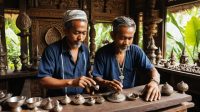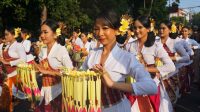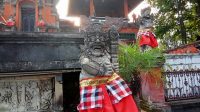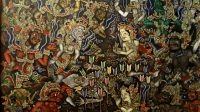PENGERUPUKAN night, the day before Nyepi Day in Bali, is always marked off with a grand and spirited parade. Amidst the roar of gamelan and dancing torches, there are giant figures known as Ogoh-Ogoh. More than just giant dolls paraded around the village, Ogoh-Ogoh is a manifestation of stunning craft art, full of deep cultural philosophy, a free expression of art, has psychological benefits for the community, and is now a unique and world-class tourist attraction.
Details and Process of Making Ogoh-Ogoh
From a craft art perspective, Ogoh-Ogoh is a collaborative masterpiece involving creativity, technical skills, and mutual cooperation of the banjar (hamlet) community (traditional village community). The process of making it can take weeks, even months, involving various stages that require precision and expertise.
The basic framework of Ogoh-Ogoh is usually made of woven bamboo and assembled in such a way as to form a sturdy yet lightweight structure for parading. The forms are very diverse, often depicting mythological figures such as giants (buta kala), gods and goddesses, or even representations of contemporary social issues.
After the framework is formed, layers of material are added to give volume and detail to the figure. In the past, the main material used was used paper that was glued and shaped. However, as time goes by, the use of styrofoam and other synthetic materials has become more common due to its ease of shaping and durability. As the latest development, today it should be made from eco-friendly materials. Plastic, styrofoam and the like are no longer allowed.
The finishing touch lies in the coloring process and the installation of ornaments. Bright and striking colors dominate, giving a dramatic and frightening impression according to the character that is to be displayed. Ornaments such as hair made of coconut fiber, teeth made of wood, colorful fabrics, and other accessories are added to strengthen the expression and visual details of Ogoh-Ogoh.
Every detail of the Ogoh-Ogoh, from the fierce facial expressions, dynamic body postures, to the intricate ornaments, reflects the craftsman’s skill in processing materials and conveying visual messages. The process of making Ogoh-Ogoh becomes an arena for limitless creativity, where wild ideas and imagination are realized in amazing three-dimensional forms.
Deep Cultural Philosophy: Symbols of Bhuta Kala and Self-Cleansing
More than just a work of visual art, Ogoh-Ogoh has a deep philosophical meaning in the Hindu Dharma tradition in Bali. Ogoh-Ogoh symbolically represents Bhuta Kala, namely negative forces, evil spirits, and all forms of bad energy that can disrupt the balance of nature and human life.
The process of making Ogoh-Ogoh and the parade on the night of Pengerupukan is a large-scale cleansing ritual (mecaru). By manifesting negative energy in a scary physical form, the community symbolically collects and parades these bad energies out of their environment.
The burning of Ogoh-Ogoh at the end of the parade symbolizes the destruction or neutralization of these negative forces. It is hoped that with the harmonization of Bhuta Kala, Nyepi Day can be carried out in a holy, calm, and peaceful atmosphere, allowing Hindus to introspect and cleanse themselves spiritually.
This philosophy teaches the importance of balance between positive and negative forces (Rwa Bhineda) in life. The existence of Ogoh-Ogoh is a reminder of the potential for negative energy and the importance of efforts to control it in order to create harmony
Free Artistic Expression: Unlimited Creativity and Community Expression
Ogoh-Ogoh is also a place for free and creative artistic expression for the Balinese people, especially the younger generation. There are no strict limitations in terms of the shape, size, or theme of Ogoh-Ogoh. Creativity is the main key in creating unique and eye-catching works.
Through Ogoh-Ogoh, the community can convey various messages, both traditional and contemporary. Mythological figures remain the main inspiration, but Ogoh-Ogoh often also depicts social, political, or environmental issues currently being discussed. This makes Ogoh-Ogoh an effective visual communication medium that is relevant to the times.
The process of making Ogoh-Ogoh also fosters a sense of togetherness and mutual cooperation among members of the banjar. Ideas are discussed together, tasks are divided, and all members contribute according to their respective abilities. This collective spirit is an important part of the Ogoh-Ogoh tradition, strengthening the bonds of brotherhood and strengthening community identity.
Psychological Benefits
Participation in the making and parade of Ogoh-Ogoh has significant psychological benefits for the Balinese people. The creative process of designing and making Ogoh-Ogoh can be a means of releasing emotions and self-expression. Manifesting fear, worry, or even social criticism in the form of scary figures can provide a collective cathartic effect.
The Ogoh-Ogoh Parade is also a place of entertainment and joy for the community. The cheers of the audience, the accompaniment of uplifting gamelan music, and the dramatic appearance of the Ogoh-Ogoh create a lively festival atmosphere. This joy can reduce stress and increase a sense of togetherness.
In addition, the Ogoh-Ogoh tradition also plays an important role in strengthening Balinese cultural identity. Through active participation in this tradition, the younger generation learns about the values of Balinese culture, mythology, and crafts. This helps preserve the cultural heritage of their ancestors and fosters a sense of pride in their identity as Balinese.
A Unique and World-Class Tourism Attraction
Along with Bali’s popularity as a world tourism destination, the Ogoh-Ogoh parade has become a unique and world-class tourist attraction. Thousands of tourists from various countries come to Bali on purpose to witness the excitement and uniqueness of this tradition.
The presence of Ogoh-Ogoh provides an unforgettable cultural experience for tourists. They are not only treated to a spectacular visual performance, but also have the opportunity to understand the philosophy and cultural meaning contained therein. This contributes to Bali’s image as a destination rich in authentic traditions and culture.
The local government and various related parties are increasingly aware of the tourism potential of the Ogoh-Ogoh tradition. Efforts to preserve and develop this tradition continue to be carried out, including through the Ogoh-Ogoh festival which showcases the best works from various banjar. However, it is important to ensure that tourism development does not erode the sacred values and cultural essence of the Ogoh-Ogoh tradition itself.
Conclusion
Ogoh-Ogoh is a rich and complex manifestation of Balinese art, culture, and local wisdom. More than just a giant puppet, it is a visual representation of the Bhuta Kala philosophy, a stunning expression of craft art, a vessel for the expression of community creativity, a means of psychological catharsis, and now a unique and global tourist attraction.
Through Ogoh-Ogoh, we can see how tradition and innovation can go hand in hand, how art can be a medium to convey cultural and social messages, and how a local ritual can have global appeal without losing its essence and meaning. The preservation and development of the Ogoh-Ogoh tradition in a sustainable manner will not only preserve Bali’s cultural heritage, but also strengthen its position as a cultural and character-based tourist destination in the eyes of the world. (*)










